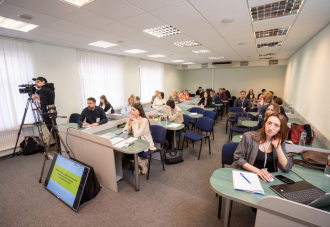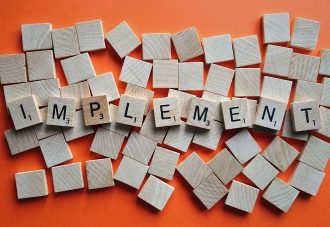In December, as part of the Initiative “Stabilization and Development of Networks/Communities/Organizations through the Use of Organizational Coaching Tools”, training was held for CSO leaders and managers on “How to keep teams together in the face of uncertainty and achieve goals”.
Yaroslav Bondarchuk, an organizational and team coach, shared with the participants the tips and tools that can help organize teamwork. The discussion focused on the team, goals, uncertainty, and their interconnection.
According to the lecturer, the world we live in is characterized by instability, uncertainty, complexity, and ambiguity. At the same time, it is becoming increasingly difficult to answer the questions “Who? What? Where? When and How?”.
Yaroslav Bondarchuk said that the answer to the challenges of the modern world is vision (a vision of where we are going to), understanding (of the fears, needs, expectations of your audience and colleagues within the team), clarity (in terms of roles, areas of responsibility, personal goals) and flexibility (adaptability).
“We need to be ready for changes and adaptation as a constant process,” the lecturer is convinced.
Team canvas for aligning vision, understanding and clarity

At the heart of the model is an element that describes why the team exists in the first place. This part is responsible for the mission.
Separate blocks are responsible for what is valuable to the team, what the needs of the team members are, what the strengths and weaknesses are. There is also a part in the model that is responsible for clarity: what roles are needed to achieve the goal and who performs them, what the areas of responsibility are. A separate part is allocated for personal goals that a person wants to achieve within the team, which may be related to the development of certain competencies.
This tool is suitable for teams of up to 15 people, but preferably fewer. If there are more people, then they should be divided into several autonomous teams/units, but with a common goal.
The team works with this tool together, filling out the file. To do this, you can hold a team meeting lasting several hours.
How to stay flexible in the face of uncertainty?
Sometimes changes happen gradually and are not always easy to notice. Then how can we understand that something is changing and we need to adapt?
Yaroslav Bondarchuk advises using an empirical approach: “We take our own experience, and then, using the three pillars of empiricism (transparency, inspection, and adaptation), we gain new experience and thus adapt.

Regular retrospectives
This is the type of meeting that should be held regularly in a team, depending on the project intensity. The best time frame for such a retrospective is 2-3 weeks.
Yaroslav Bondarchuk advises that during such a meeting, you should review what was planned, what was achieved, what was not, what helped the team and what hindered it, what you should start doing to get closer to the goal, and what you should stop doing.
This way, we have time set aside in the calendar to inspect and adapt the process we work with, as well as our final product.
What can hinder team development?
Yaroslav Bogdarchuk shared information with the participants of the training about what can hinder team development.

According to the lecturer, this is a fairly popular model that consists of such items as lack of trust, fear of conflict, irresponsibility, undemandingness, and indifference to results. And all these things are quite dangerous for teams.
The most common causes of such dysfunctions are:
- Fear of being vulnerable;
- Artificial harmony (when we pretend that everything is fine);
- Irresponsibility often arises due to uncertainty, and undemandingness arises due to personal discomfort;
- Indifference to the results is most often caused by selfish attitudes and “political games” in a team or organization (for example, when we know that we are doing work that no one will need).
“The first two dysfunctions are generally about psychological safety: how much I can disagree, share my vision, argue, and conflict productively. It’s all about psychological security. Without it, the rest of the things will not make sense”, added Yaroslav Bondarchuk.
The material was prepared by Kseniia Ditchuk
Mentorship Program is implemented as part of the Project “Ukraine Civil Society Sectoral Support Activity” implemented by the Initiative Center to Support Social Action “Ednannia” in partnership with the Ukrainian Center for Independent Political Research (UCIPR) and Centre for Democracy and Rule of Law with the sincere support of the American people through United States Agency for International Development.



